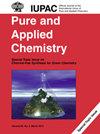Method development for multielement determination of halogens and sulfur in teas
IF 2
4区 化学
Q3 CHEMISTRY, MULTIDISCIPLINARY
引用次数: 0
Abstract
Microwave-induced combustion was evaluated as a sample preparation method for several types of tea (black, green, lemon balm, boldo, and mint) for further determination of bromine, chlorine, fluorine, iodine, and sulfur by ion chromatography. Parameters such as the sample mass efficiently decomposed and the most suitable absorbing solution (ultrapure water and 25, 50, 100, and 150 mmol L茶叶中卤素和硫的多元素测定方法开发
评估了微波诱导燃烧作为几种茶叶(红茶、绿茶、柠檬香膏、波尔多茶和薄荷茶)的样品制备方法,以便通过离子色谱法进一步测定溴、氯、氟、碘和硫。考虑到分析物的特性和所使用的测定技术,对有效分解的样品质量和最合适的吸收溶液(超纯水和 25、50、100 和 150 mmol L-1 NH4OH)等参数进行了评估。可分解的最大样品量为 900 毫克磨碎的颗粒状茶叶,选择的吸收液为 100 毫摩尔/升-1 NH4OH,这为分析物提供了合适的稳定性(回收率在 95 % 至 103 % 之间)。为了评估所建议方法的准确性,对认证参考物质(BCR 060,水生植物)进行了分析。与认证值的一致性在 101 % 到 107 % 之间。使用拟议方法分析茶叶样品,氯的浓度范围为 549 至 2,549 毫克/千克-1,氟的浓度范围为 223 至 828 毫克/千克-1,硫的浓度范围为 786 至 4,023 毫克/千克-1;在所有评估的样品中,溴和碘的浓度均低于定量限(分别为 42 和 80 毫克/千克-1)。
本文章由计算机程序翻译,如有差异,请以英文原文为准。
求助全文
约1分钟内获得全文
求助全文
来源期刊

Pure and Applied Chemistry
化学-化学综合
CiteScore
4.00
自引率
0.00%
发文量
60
审稿时长
3-8 weeks
期刊介绍:
Pure and Applied Chemistry is the official monthly Journal of IUPAC, with responsibility for publishing works arising from those international scientific events and projects that are sponsored and undertaken by the Union. The policy is to publish highly topical and credible works at the forefront of all aspects of pure and applied chemistry, and the attendant goal is to promote widespread acceptance of the Journal as an authoritative and indispensable holding in academic and institutional libraries.
 求助内容:
求助内容: 应助结果提醒方式:
应助结果提醒方式:


